◆ 121 Property from the Collection of Renzo Brugola Ettore Sottsass Jr. Follow Important frieze circa 1965 Glazed earthenware. 30 x 710 x 0.7 cm (11 3/4 x 279 1/2 x 0 1/4 in.) Produced by Bitossi, Montelupo Fiorentino, Italy.
Provenance Renzo Brugola, Lissone Thence by descent Exhibited 'La casa abitata', Palazzo Strozzi, Florence, 6 March-25 April 1965 Literature 'Ettore Sottsass jr.: una stanza da letto’, Domus , no. 426, May 1965, illustrated pp. 52-3, 55 Fernanda Pivano, C'era una volta un beat. L'avventura degli anni '60 , Milan, 1988, illustrated p. 102 Hans Höger, Ettore Sottsass Jun. Designer, Artist, Architect , Tübingen, 1993, illustrated p. 86 Milco Carboni, Ettore Sottsass Jr. ’60-’70 , exh. cat., FRAC Centre, Orléans, 2006, illustrated pp. 88-89 Catalogue Essay Colour-Light Colour-Space The idea that the main embryos of expression are born from the qualities of different surfaces is illustrated by the ‘long and passionate exercise of Sottsass as a ceramist, meticulous calibrator of thicknesses, opacities and transparencies of colours’. (Santini, ‘Le pitture di Ettore Sottsass 1963-64’, Domus , no. 420, 1964, pp. 36-38). Within the specifics of this instance, the choice to use ceramic tiles for a panel represents a sort of suspension of his creative process: it is ceramic-painting-structure. Sottsass' research extends to the most disparate areas, whilst maintaining a uniform stylistic language. It is no coincidence that Sottsass spent many of his days with ironmongers, carpenters, glass blowers and ceramists, in a constant quest to understand ‘what could happen if the emptiness, the empty space, the solid idea of empty space were cut in pieces by the presence of lines, surfaces, any type of trajectories and matter, including the light inside the solid of emptiness’ (Sottsass, Scritto di notte , 2010, p. 130). His experimental studies of structure and colour help find solutions to the recurring issue of decoration: colour, light and symbols are not decorative elements, but also act as structure. ‘The light that enters a room doesn’t get lost in an empty space’, it is captured and modulated by the gloss and matt ceramic tiles. Colour becomes the main source of atmospheric coordination within an environment (Santini, ‘Introduzione a Sottsass’, Zodiac , 1963). Following this approach, Sottsass in his proposal for the Florentine exhibition ‘La casa abitata’, presents his idea of ‘habitability’ with an ‘invented and enclosed bedroom, designed to generate maximum tension, all of which is supported by a precious and highly calibrated balance between colour-light and colour-space’ (Masini 1965, pp. 50-51). The ‘Camera da letto’ (Bedroom) or ‘Stanza dell’amore’ (Room of Love), as it was originally called before it was censored by the Florentine Curia, is a habitable room, ‘it’s an environment controlled in every detail, but it is also a declaration of intentions’ to be diffused through the written introduction (from the Kama Sutra) and the accompanying photographs. (Carboni 2017, p.110). It is a conceptual guideline to encourage reflection by its users and others. For Sottsass, love, the idea of making love is ‘consciously the centre of life’ and, despite any judgments, he will continue ‘to design miserable bedrooms of a disgusting pink for young ladies, with pictures that look like sweets; a failed sexual symbol, among few rows of ceramics made in an attempt to bring inside the room, inside love, those things that we see in the sky, those lights that keep on changing as time passes; I will continue to create some miserable bedrooms and put perfumes and flowers and books and a table to make drawings to suggest another way to live, hoping that the way young people make love one day will win over all the hate and all the pain’ ( La casa , 1965, p. 231). The Frieze, comprised of 35 tiles, with polychrome glaze, is presumably from Sottsass’ ‘Camera da letto’ (Bedroom), designed for ‘La casa abitata’, an exhibition held in Palazzo Strozzi, Florence in the spring of 1965. The present lot appears to be a portion of the frieze, installed around the room. The vertical sequel of the tiles (parallel bands and chromatic scales) create a dynamic composition p
◆ 121 Property from the Collection of Renzo Brugola Ettore Sottsass Jr. Follow Important frieze circa 1965 Glazed earthenware. 30 x 710 x 0.7 cm (11 3/4 x 279 1/2 x 0 1/4 in.) Produced by Bitossi, Montelupo Fiorentino, Italy.
Provenance Renzo Brugola, Lissone Thence by descent Exhibited 'La casa abitata', Palazzo Strozzi, Florence, 6 March-25 April 1965 Literature 'Ettore Sottsass jr.: una stanza da letto’, Domus , no. 426, May 1965, illustrated pp. 52-3, 55 Fernanda Pivano, C'era una volta un beat. L'avventura degli anni '60 , Milan, 1988, illustrated p. 102 Hans Höger, Ettore Sottsass Jun. Designer, Artist, Architect , Tübingen, 1993, illustrated p. 86 Milco Carboni, Ettore Sottsass Jr. ’60-’70 , exh. cat., FRAC Centre, Orléans, 2006, illustrated pp. 88-89 Catalogue Essay Colour-Light Colour-Space The idea that the main embryos of expression are born from the qualities of different surfaces is illustrated by the ‘long and passionate exercise of Sottsass as a ceramist, meticulous calibrator of thicknesses, opacities and transparencies of colours’. (Santini, ‘Le pitture di Ettore Sottsass 1963-64’, Domus , no. 420, 1964, pp. 36-38). Within the specifics of this instance, the choice to use ceramic tiles for a panel represents a sort of suspension of his creative process: it is ceramic-painting-structure. Sottsass' research extends to the most disparate areas, whilst maintaining a uniform stylistic language. It is no coincidence that Sottsass spent many of his days with ironmongers, carpenters, glass blowers and ceramists, in a constant quest to understand ‘what could happen if the emptiness, the empty space, the solid idea of empty space were cut in pieces by the presence of lines, surfaces, any type of trajectories and matter, including the light inside the solid of emptiness’ (Sottsass, Scritto di notte , 2010, p. 130). His experimental studies of structure and colour help find solutions to the recurring issue of decoration: colour, light and symbols are not decorative elements, but also act as structure. ‘The light that enters a room doesn’t get lost in an empty space’, it is captured and modulated by the gloss and matt ceramic tiles. Colour becomes the main source of atmospheric coordination within an environment (Santini, ‘Introduzione a Sottsass’, Zodiac , 1963). Following this approach, Sottsass in his proposal for the Florentine exhibition ‘La casa abitata’, presents his idea of ‘habitability’ with an ‘invented and enclosed bedroom, designed to generate maximum tension, all of which is supported by a precious and highly calibrated balance between colour-light and colour-space’ (Masini 1965, pp. 50-51). The ‘Camera da letto’ (Bedroom) or ‘Stanza dell’amore’ (Room of Love), as it was originally called before it was censored by the Florentine Curia, is a habitable room, ‘it’s an environment controlled in every detail, but it is also a declaration of intentions’ to be diffused through the written introduction (from the Kama Sutra) and the accompanying photographs. (Carboni 2017, p.110). It is a conceptual guideline to encourage reflection by its users and others. For Sottsass, love, the idea of making love is ‘consciously the centre of life’ and, despite any judgments, he will continue ‘to design miserable bedrooms of a disgusting pink for young ladies, with pictures that look like sweets; a failed sexual symbol, among few rows of ceramics made in an attempt to bring inside the room, inside love, those things that we see in the sky, those lights that keep on changing as time passes; I will continue to create some miserable bedrooms and put perfumes and flowers and books and a table to make drawings to suggest another way to live, hoping that the way young people make love one day will win over all the hate and all the pain’ ( La casa , 1965, p. 231). The Frieze, comprised of 35 tiles, with polychrome glaze, is presumably from Sottsass’ ‘Camera da letto’ (Bedroom), designed for ‘La casa abitata’, an exhibition held in Palazzo Strozzi, Florence in the spring of 1965. The present lot appears to be a portion of the frieze, installed around the room. The vertical sequel of the tiles (parallel bands and chromatic scales) create a dynamic composition p
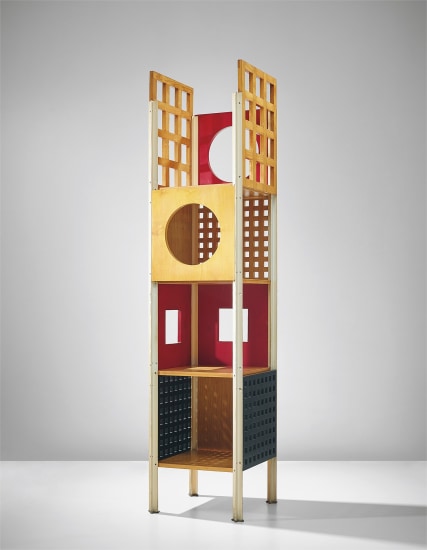






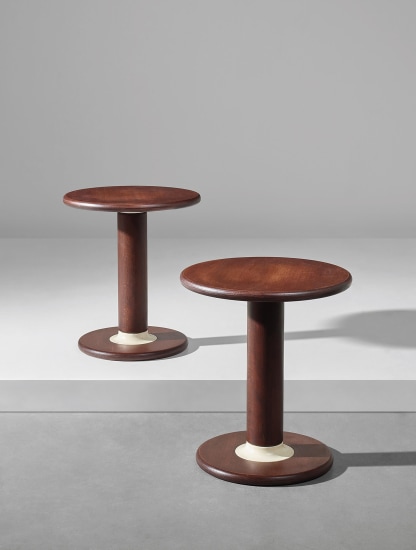
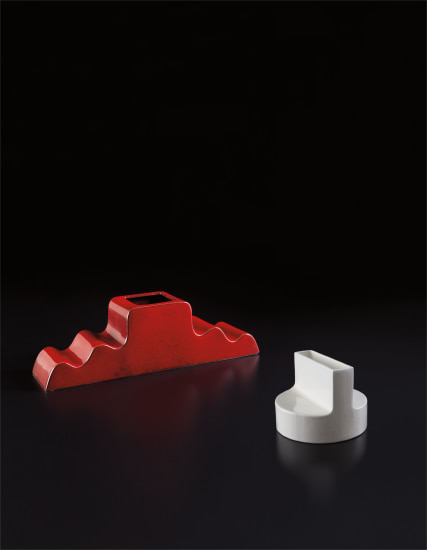
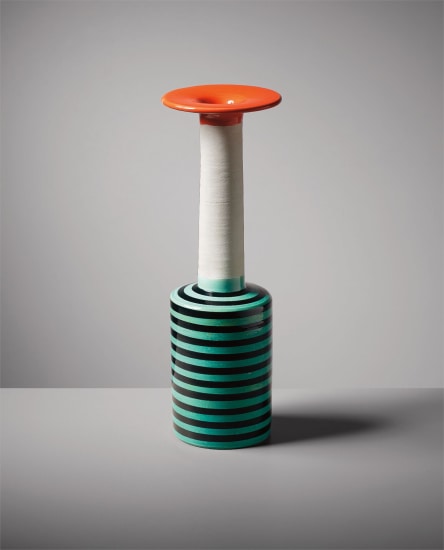
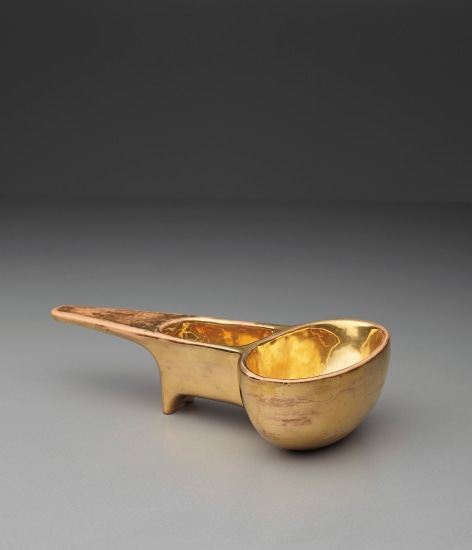
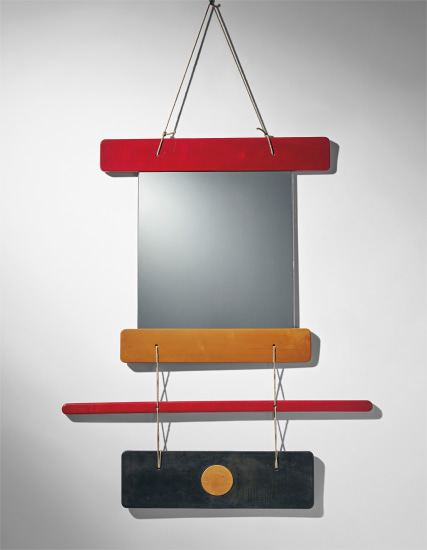

Testen Sie LotSearch und seine Premium-Features 7 Tage - ohne Kosten!
Lassen Sie sich automatisch über neue Objekte in kommenden Auktionen benachrichtigen.
Suchauftrag anlegen